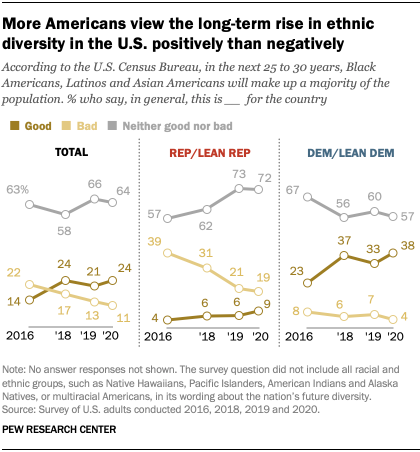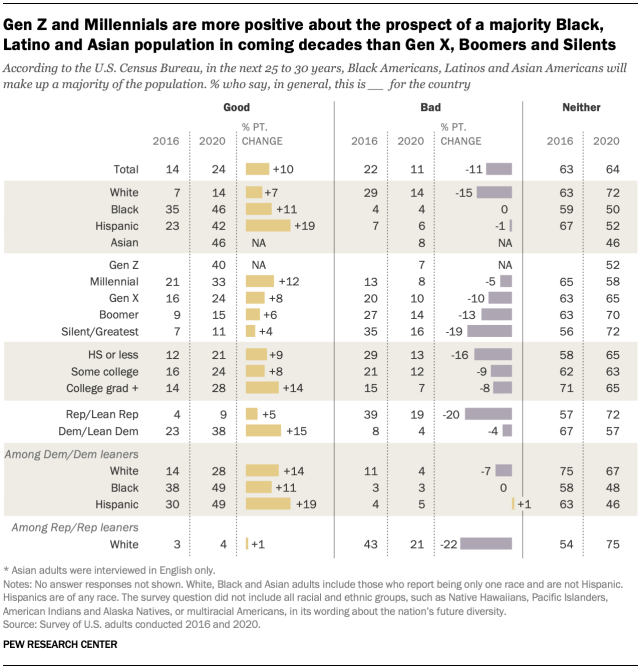The United States is more racially and ethnically diverse today than it ever has been, and it is projected to be even more diverse in the coming decades. In 2019, Americans who identify as a race or ethnicity other than non-Hispanic White made up 40% of the country’s population, and their combined share is predicted to increase to over 50% by 2044, according to the U.S. Census Bureau.
Americans continue to mostly say these long-term shifts are neither good nor bad for the country. However, the share that views the long-term growth of racial and ethnic diversity as good for the U.S. is higher than it was in 2016.
Currently, 64% of U.S. adults say the prospect of a nation in the next 25 to 30 years in which Black Americans, Latinos and Asian Americans make up a majority of the population is neither good nor bad for the country. Nearly a quarter (24%) say this is a good thing, while fewer than half as many (11%) say it is bad, according to a national survey by Pew Research Center, conducted July 27-Aug. 2 among 11,001 adults. (The survey question did not include all racial and ethnic groups, such as Native Hawaiians, Pacific Islanders, American Indians and Alaska Natives, or multiracial Americans, in its wording about the nation’s future diversity.)
Pew Research Center conducted this study to understand Americans’ views of long-term racial and ethnic change in the country, and how these attitudes have changed in recent years. For this analysis, we conducted an online survey of 11,001 U.S. adults between July 27 and Aug. 2, 2020.
Everyone who took part is a member of the Center’s American Trends Panel (ATP), an online survey panel that is recruited through national, random sampling of residential addresses. This way nearly all U.S. adults have a chance of selection. The survey is weighted to be representative of the U.S. adult population by gender, race, ethnicity, partisan affiliation, education and other categories. Read more about the ATP’s methodology. Here are the questions used for this report, along with responses, and its methodology.
While these views have changed little since 2018, the public expresses more positive – and less negative – views of the long-term rise in racial and ethnic diversity than it did four years ago, during the last presidential campaign. Since then, the share saying a majority Black, Hispanic and Asian population is a good thing has increased by 10 percentage points, while there has been a comparable decline (11 points) in the share saying it is bad thing.
The overall decline in shares who say that the long-term growth in racial and ethnic diversity is bad for the country has been primarily driven by Republicans and Republican-leaning independents. While Republicans are more likely than Democrats to say this change would be bad for the country (19% of Republicans vs. 4% of Democrats), the share of Republicans who express this view has declined by 20 points since 2016.
Compared with 2016, Republicans are not substantially more likely to say that this would be good for the country (4% in 2016 and 9% today), but the share who say it is neither good nor bad for the country has increased by 15 points, making up an increasingly large majority of Republicans (72%).
On the other hand, a growing share of Democrats and Democratic leaners say that a majority Black, Latino and Asian nation is a good thing for the country; since 2016, the share saying this has increased by 15 percentage points to 38%. The share of Democrats who say it is neither good nor bad has declined 10 points since 2016 (to 57% today).
Compared with 2016, larger shares in nearly all demographic groups express positive views of the prospect of a U.S. where Black, Latino and Asian Americans make up a majority of the nation’s population. Still, majorities in most groups view this development as neither bad nor good for the country.
Black (46%), Asian (also 46%) and Hispanic adults (42%) are far more likely than White adults (14%) to say that the long-term growth in racial and ethnic diversity is a good thing for the country. Across racial and ethnic groups for which there is trend data, larger shares say this than did so in 2016. The increase has been especially striking among Hispanic adults (from 23% then to 42% now).
These differences across racial and ethnic groups persist among Democrats and Democratic leaners – White Democrats are less likely (28%) than Hispanic (49%) and Black Democrats (49%) to say that the prospect of a majority non-White nation is good for the country.
Within generational groups, Gen Zers and Millennials are more likely than older generations to view a Black, Latino and Asian majority as a good thing, and Millennials have become even more likely to hold this view compared with four years ago. But among those who view this population change as bad, there exists little generational difference. This is in part due to the large drops in shares over the past four years among older generations who say the prospect of a future U.S. where Black, Latino and Asian Americans are the majority is bad for the country.
There is also little attitudinal difference observed across education levels. Overall, those with only a high school degree or less have become less opposed toward the prospect of a diversifying population over the past four years, though a slightly larger share of college-educated Americans (28%) view this potential change as a good thing for the country.

